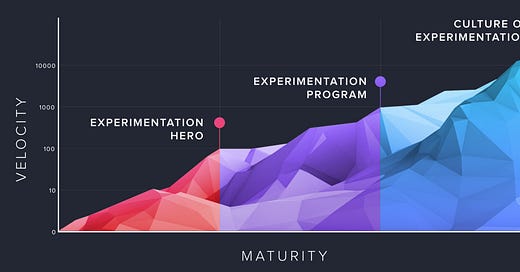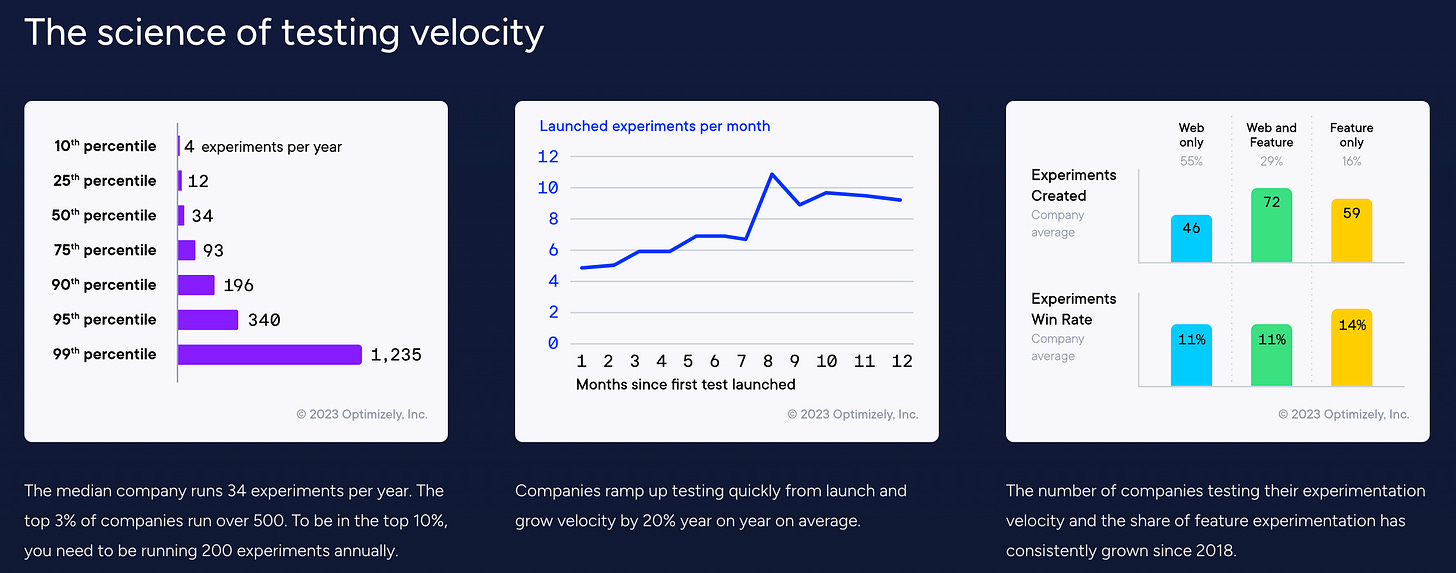Experimentation is crucial; there's no way around it. This is particularly true for startups that have found Product-Market Fit (PMF) and are looking to scale.
On the other hand, your startup might already have some level of experimentation tracking but is ready to ramp up the velocity and resource allocation.
In either scenario, the following content is tailored for you, where I discuss:
Why it's important to experiment early?
How to define a transition phase for a startup?
What are the some of the key challenges for startups?
What framework I have used to scale up?
What are best practices to scale up such program?
Why is important to start experimenting early?
Running a startup is inherently dynamic and uncertain, where the line between success and failure is often razor-thin. Building a culture and process of experimentation is not just a strategy but a necessity for survival and growth.
Here are a few reasons why starting an experimenting shift early is vital:
Navigating the unknown
Traditional business strategies based on predictions and forecasts may fall short amidst rapid technological advancements and shifting consumer behaviors. Experimentation allows startups to test hypotheses in real-world scenarios, providing concrete data that guides decision-making.
Minimising risks and resource optimization
In the lean early stages of a startup, resources are scarce, and every new initiative carries inherent risk. Experimentation acts as a safeguard, allowing startups to cautiously test new ideas before fully committing resources. This approach enables efficient allocation of time and budget by focusing on strategies proven to work through controlled testing.
Accelerating PMF
Achieving product-market fit—a scenario where the product satisfies a strong market demand—is one of the most critical challenges for startups. Experimentation accelerates this process by enabling startups to iteratively test product features, pricing models, and market segments, quickly learning from feedback and adapting their offering.
A great source here for list of experiment you can run ( and brainstorm further ): https://www.accelerate.thedelta.io/insights/experimentation-experiments-that-founders-can-use-to-validate-their-way-into-the-market
Foster a culture of innovation
Beyond practical benefits, embracing experimentation fosters a culture of curiosity, learning, and resilience within the startup. It encourages teams to question assumptions, pursue innovative solutions, and view failures not as setbacks but as opportunities for growth.
The transition phase for a startup
From my involvement in multiple experimentation programs, the transition phase typically represents a pivotal moment in every startup's journey. This phase marks when leaders within the company start moving away from smaller-scale experiments to adopting more structured and comprehensive programs, supported by deeper data analysis and statistical outputs.
..but when a startups transit or what are the common triggers for that?
Market Expansion
As startups look to grow beyond their initial market segments, understanding new customer bases and adapting offerings to fit diverse needs becomes crucial.
Product Diversification
Introducing new products or features is a natural step for startups as they seek to capture more value and meet their customers' evolving needs. Each addition introduces new variables and complexities, necessitating a scaled-up experimentation approach to validate demand, optimize user experience, and ensure alignment with the existing product ecosystem.
Seeking Deeper Customer Insights
Gaining a deep understanding of customer behavior and preferences is essential for fine-tuning PMF and driving user engagement. As startups mature, sophisticated experimentation methods become paramount for gleaning nuanced insights, moving beyond basic A/B testing to more complex experimental designs.
What are the some of the key challenges for startups?
Of course, like every adoption of a new direction and mindset, there are also challenges that each startup experiences.
Setting up > Running > Analyzing > Reiterating is an exhaustive dynamic for any team, which is why it is important to cut early and cut fast.
Below are some of the key challenges I can think of during the time I'm engaged with startups:
The most obvious one, resource allocation → You are walking on thin ice here, as on one side you need to preserve cash to prolong your run-rate as a startup as much as you can, while on the other, you need to grow at a certain scale month-over-month to unlock more revenue and future funding.
Not reducing the quality of the experiments → The more you run, the more divided your attention becomes, the more pressure you have to deliver, which translates to rushing to “conclude the current one and start quickly on the next experiment.
Lack off good “data management” practices → With the increase in experimentation comes a surge in data, presenting challenges in terms of collection, storage, analysis, and interpretation.
Bad organisational alignment → As experimentation programs scale, ensuring that experiments are aligned with the broader strategic goals of the startup becomes increasingly challenging. This is where you start failing the most!
The strategic methodology I`m using as a growth leader
It's a basic framework that focuses on three core areas, not just within the experimentation domain, but across your whole organization. To make it easy to read, I will use a method called "Phase-Based Structure":
Step 1: Infrastructure & Tools
What is the objective?
Since we are scaling our experimentation efforts, the objective is to establish a robust technological foundation that supports the complexities of large-scale data collection, analysis, and management.
What are the key components?
I'm sure there might be more, but I can stick with three of them for this framework:
→ The key one is a “data collection tool” that captures the wide range of data types across various/all customer touchpoints.
→ You cannot escape the statistical importance and complexities, so it's important to have either an in-house built or third-party “analysis software”.
→ Data distribution (for any experiment) is only possible with a good “management system,” which can ensure a high level of data integrity, security, and accessibility.
Step 2: Process & Governance
What is the objective?
While running small-scale experiments allows people to develop the mindset of “spaghetti on the wall,” when you want to scale, there should be a clear process and some level of governance ( experiments = business objectives ).
What are the key components?
→ Standardized methodologies in the face of clear guidelines for designing, implementing, and analyzing experiments.
→ A favorite of mine, a “Prioritisation Framework,” is needed as well, as the more you grow not just as experiments, but as a team, more ideas will start to float around as well as balancing not to work on the same customer problem areas only.
→ Governance mechanisms are needed as well, as they can oversee the whole experimentation pipeline and efforts and see if they contribute to the overall business goals, etc.
Step 3: Culture & Team
What is the objective?
Experimentation is not just baked into the numbers but in the company/team culture as well. The main objective is to cultivate a culture that values experimentation and learning, hugely supported by cross-functional teams.
What are the key components?
→ The main one, as I've said above, is the “cultural shift,” where leaders need to encourage a mindset that views experimentation as an essential lever for innovation and growth.
→ Second is “skill development,” where organisations need to invest in training and development to equip team members with the skills needed for effective experimentation, including data analysis, experimental design, and strategic thinking.
→ I would say this is the key one for me: “cross-functional collaboration.” You cannot scale an experimentation program without this component in the framework, period! Whatever you do, make sure you streamline teamwork across departments, making the experimentation outcome a common goal for success.
What are best practices to scale up such a program?
A post without "best practices" is not complete. Considering the vast amount of information already shared, I will suggest the most critical advice from my experience. Even though experimentation follows similar patterns across startups, your current state (resources, talent, etc.) and customer needs can be very different.
Define crystal clear objectives
An experimentation program without clear goals and a path to success is already on the path to failure. Defining such goals, not just for yourself and your team but for the company as well, ensures everyone can see the expected outcomes and hold you accountable.
Lead by example
Typically, experimentation programs fall under a Product Leader or a Head of Growth. Regardless of who the leader is, you must always enforce clear collaboration between different departments. You cannot run experiments alone.
Aim for high fail rate
I've mentioned this many times, but one of your team's primary KPIs should be the "% of failed experiments." This ensures that you are constantly learning and iterating. If, by any chance, you have a success rate of over 20% across all experiments, you might be setting goals that are too easy, or there is something wrong with your analysis.
According to Optimizely around 88% of the tests do not win.
Avoid the statistical madness
In high-velocity startups where scaling is already underway, it's essential not to overcomplicate the reliance on statistical terminology and interpretation. They are indicators of how your tests perform, but avoid getting trapped in spreading them across dashboards and in "reporting" meetings, because not everyone has the same context as you, and not everyone cares if your "error rate" is precise.






